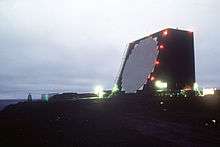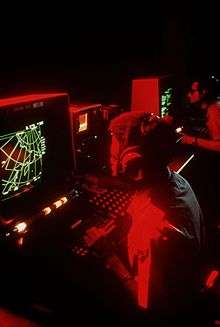Cobra Dane
The AN/FPS-108 COBRA DANE is a PESA phased array radar installation operated by Raytheon for the United States Air Force at Eareckson Air Station on the island of Shemya, Aleutian Islands, Alaska.[1] This radar system was built in 1976 and brought on-line in 1977 for the primary mission of gathering intelligence about Russia's ICBM program in support of verification of the SALT II arms limitation treaty. Its single face 29 m (95 ft) diameter phased array radar antenna 52.7373°N 174.0914°E faces the Kamchatka Peninsula and Russia's Kura Test Range. COBRA DANE operates in the 1215–1400 MHz band.[2]



The "COBRA" designation indicated a General Defense Intelligence Program.[3]
It initially employed a Control Data Corporation Cyber 74 mainframe computer for data processing.[4] Data from the radar is sent to the North American Aerospace Defense Command (NORAD) at Peterson Air Force Base, Colorado. It is also listed as a partner of the NASA Orbital Debris Program Office and works with the Missile Defense Agency,[1] under the control of the 21st Operations Group.[5]
The Cobra Dane radar has been upgraded to be integrated in the Missile Defenses Agency's (MDA) Ballistic Missile Defense System (BMDS). The improvement includes midcourse BMDS sensor coverage by providing acquisition, tracking, object classification, and data that can be used for cueing, launch of interceptor missiles, and course updates of interceptors while retaining the site's legacy intelligence and space track missions. The Air Force maintains responsibility for the Cobra Dane radar operations, maintenance, and sustainment.[6]
Technical Specifications
- Traveling wave tube fed phased-array, all-weather, long-range radar
- Provides midcourse coverage for the BMDS. Detects sea-launched or intercontinental ballistic missiles Classifies reentry vehicle and other missile objects. Provides real-time information to Fire Control. Provides tracking of threat ballistic missiles sufficiently accurate to commit the launch of interceptors and to update the target tracks to the interceptor while the interceptor is in flight
- Cobra Dane has one radar face providing 136°of azimuth coverage. The radar face is approximately 95 feet in diameter; overall radar height is 120 feet. Detects objects out to 2000 miles. It operates in the L-band frequency.[7]
See also
References
- "Archived copy" (PDF). Archived from the original (PDF) on 2009-07-14. Retrieved 2009-02-27.CS1 maint: archived copy as title (link)
- "AN/FPS-108 COBRA DANE". fas.org. Retrieved 2014-10-01.
- Colonel Bill Grimes, U.R. (2014). The History of Big Safari. Archway. p. 454. ISBN 9781480804562.
- "Press report on Computer sale to PRC (THIS LINK POINTS TO THE WRONG DOCUMENT)". United States Department of State. 1976-10-30. Retrieved 2010-04-02.
- Steve Brady. "Wing adopts new (again) space surveillance mission". afspc.af.mil. Archived from the original on 2014-12-20. Retrieved 2014-12-16.
- https://www.mda.mil/system/sensors.html
- https://www.mda.mil/global/documents/pdf/cobradane.pdf
External links
- National Security Space Roadmap COBRA DANE Overview
- NASA Orbital Debris Program Office
- Raytheon - Upgrades, etc.
- Space Surveillance Sensors: The Cobra Dane Radar. Article at the Mostlymissiledefence Blog.